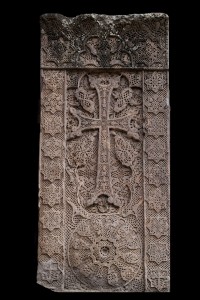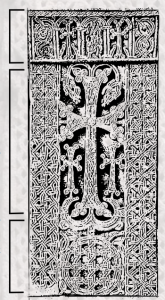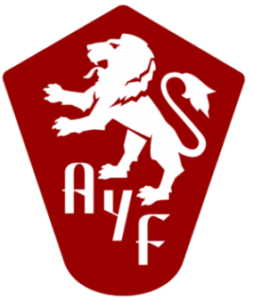Khatchkars
 Erected adjacent to the entrance of newly established cities and churches, or to commemorate military victories, khatchkars (cross-stones) have traditionally signified genesis.
Erected adjacent to the entrance of newly established cities and churches, or to commemorate military victories, khatchkars (cross-stones) have traditionally signified genesis.
Their detailed handwork characterizes many aspects of the establishment they represent. Though the contemporary use of khatchkars as gravestones have strayed from their original purpose, khatchkars have been an exclusive aspect of Armenian culture since the 9th century.
The carvings reached their peak between the 12th and 14th centuries and have remained cultural icons since. Most notably located in the historic region Nakhichevan (currently occupied by Azerbaijan), khatchkars are common throughout the Armenian Nation.
Home to the world’s largest khatchkar cemetery, the city of Old Jugha in Nakhichevan, was the nerve center of khatchkar production and distribution. Since being arbitrarily placed under Azeri control, during the Soviet-era, the area’s native Armenians have been depopulated, leaving behind precious artifacts of what the city once was. In an effort to erase all traces of Armenian-ness, the Azeri government has implemented a campaign to destroy, remove, and pave over culturally significant sites. The destruction of khatchkars has brought condemnation from the European Union, UNESCO, as well as several other international organizations and diplomats. However, the occupation and demolition continues.

Upper Part
Heavenly figures are commonplace along the top portion of traditional khatchkars. This horizontal strip signifiesparadise or the house of God where individuals attain salvation. Depictions of birds, angels, saints and Christ himself are prevalent along the commonly protruding heading of the khatchkar.
Center Part
No khatchkar is complete without a cross. Universally found in the center of the stone, the cross itself represents Jesus Christ, arms spread, crucified. This shows Christianity’s role as the holy mediator between the heavens above and the earth below. Therefore, the formation and alignment of the khatchkar as a whole suggests that Jesus is the link between eternal life and humanity.
Lower Part
Earthly decorations are customary alongside the large spherical (or triangular) emblem that is universal among khatchkars. This represents earth, the mortal home of mankind. Natural figures such as leaves are customary near the edge of the stone. These leaves symbolize the link the khatchkar as a whole shares with the natural world. It is said that the stone receives nutrients from the soil that it is erected upon because it is a part of the earth.


Leave a Reply
Want to join the discussion?Feel free to contribute!